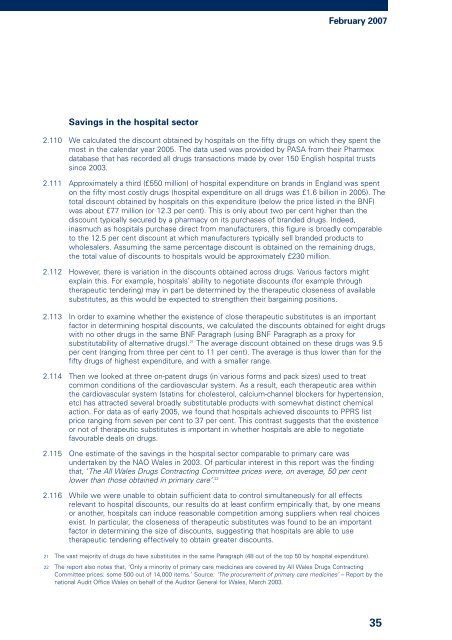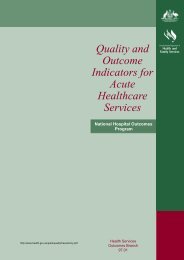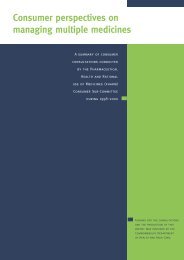The Pharmaceutical Price Regulation Scheme - Office of Fair Trading
The Pharmaceutical Price Regulation Scheme - Office of Fair Trading
The Pharmaceutical Price Regulation Scheme - Office of Fair Trading
Create successful ePaper yourself
Turn your PDF publications into a flip-book with our unique Google optimized e-Paper software.
February 2007<br />
Savings in the hospital sector<br />
2.110 We calculated the discount obtained by hospitals on the fifty drugs on which they spent the<br />
most in the calendar year 2005. <strong>The</strong> data used was provided by PASA from their Pharmex<br />
database that has recorded all drugs transactions made by over 150 English hospital trusts<br />
since 2003.<br />
2.111 Approximately a third (£550 million) <strong>of</strong> hospital expenditure on brands in England was spent<br />
on the fifty most costly drugs (hospital expenditure on all drugs was £1.6 billion in 2005). <strong>The</strong><br />
total discount obtained by hospitals on this expenditure (below the price listed in the BNF)<br />
was about £77 million (or 12.3 per cent). This is only about two per cent higher than the<br />
discount typically secured by a pharmacy on its purchases <strong>of</strong> branded drugs. Indeed,<br />
inasmuch as hospitals purchase direct from manufacturers, this figure is broadly comparable<br />
to the 12.5 per cent discount at which manufacturers typically sell branded products to<br />
wholesalers. Assuming the same percentage discount is obtained on the remaining drugs,<br />
the total value <strong>of</strong> discounts to hospitals would be approximately £230 million.<br />
2.112 However, there is variation in the discounts obtained across drugs. Various factors might<br />
explain this. For example, hospitals’ ability to negotiate discounts (for example through<br />
therapeutic tendering) may in part be determined by the therapeutic closeness <strong>of</strong> available<br />
substitutes, as this would be expected to strengthen their bargaining positions.<br />
2.113 In order to examine whether the existence <strong>of</strong> close therapeutic substitutes is an important<br />
factor in determining hospital discounts, we calculated the discounts obtained for eight drugs<br />
with no other drugs in the same BNF Paragraph (using BNF Paragraph as a proxy for<br />
substitutability <strong>of</strong> alternative drugs). 21 <strong>The</strong> average discount obtained on these drugs was 9.5<br />
per cent (ranging from three per cent to 11 per cent). <strong>The</strong> average is thus lower than for the<br />
fifty drugs <strong>of</strong> highest expenditure, and with a smaller range.<br />
2.114 <strong>The</strong>n we looked at three on-patent drugs (in various forms and pack sizes) used to treat<br />
common conditions <strong>of</strong> the cardiovascular system. As a result, each therapeutic area within<br />
the cardiovascular system (statins for cholesterol, calcium-channel blockers for hypertension,<br />
etc) has attracted several broadly substitutable products with somewhat distinct chemical<br />
action. For data as <strong>of</strong> early 2005, we found that hospitals achieved discounts to PPRS list<br />
price ranging from seven per cent to 37 per cent. This contrast suggests that the existence<br />
or not <strong>of</strong> therapeutic substitutes is important in whether hospitals are able to negotiate<br />
favourable deals on drugs.<br />
2.115 One estimate <strong>of</strong> the savings in the hospital sector comparable to primary care was<br />
undertaken by the NAO Wales in 2003. Of particular interest in this report was the finding<br />
that, ‘<strong>The</strong> All Wales Drugs Contracting Committee prices were, on average, 50 per cent<br />
lower than those obtained in primary care’. 22<br />
2.116 While we were unable to obtain sufficient data to control simultaneously for all effects<br />
relevant to hospital discounts, our results do at least confirm empirically that, by one means<br />
or another, hospitals can induce reasonable competition among suppliers when real choices<br />
exist. In particular, the closeness <strong>of</strong> therapeutic substitutes was found to be an important<br />
factor in determining the size <strong>of</strong> discounts, suggesting that hospitals are able to use<br />
therapeutic tendering effectively to obtain greater discounts.<br />
21 <strong>The</strong> vast majority <strong>of</strong> drugs do have substitutes in the same Paragraph (48 out <strong>of</strong> the top 50 by hospital expenditure).<br />
22 <strong>The</strong> report also notes that, ‘Only a minority <strong>of</strong> primary care medicines are covered by All Wales Drugs Contracting<br />
Committee prices: some 500 out <strong>of</strong> 14,000 items.’ Source: ‘<strong>The</strong> procurement <strong>of</strong> primary care medicines’ – Report by the<br />
national Audit <strong>Office</strong> Wales on behalf <strong>of</strong> the Auditor General for Wales, March 2003.<br />
35




